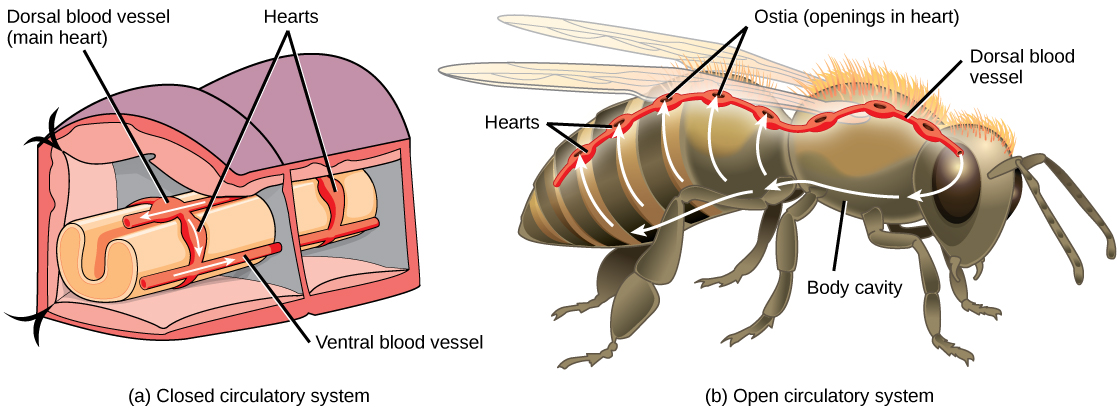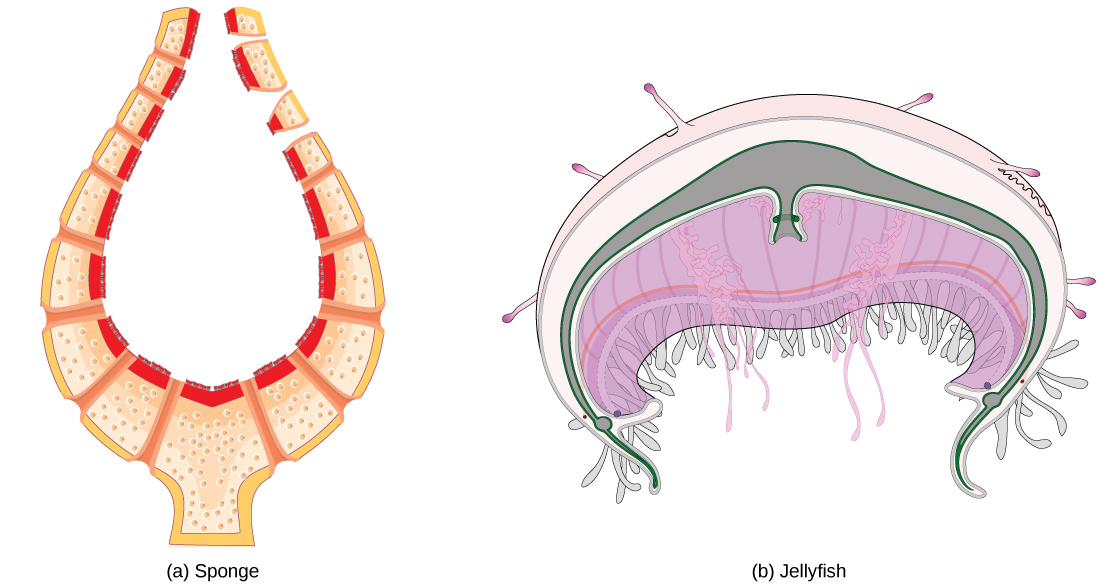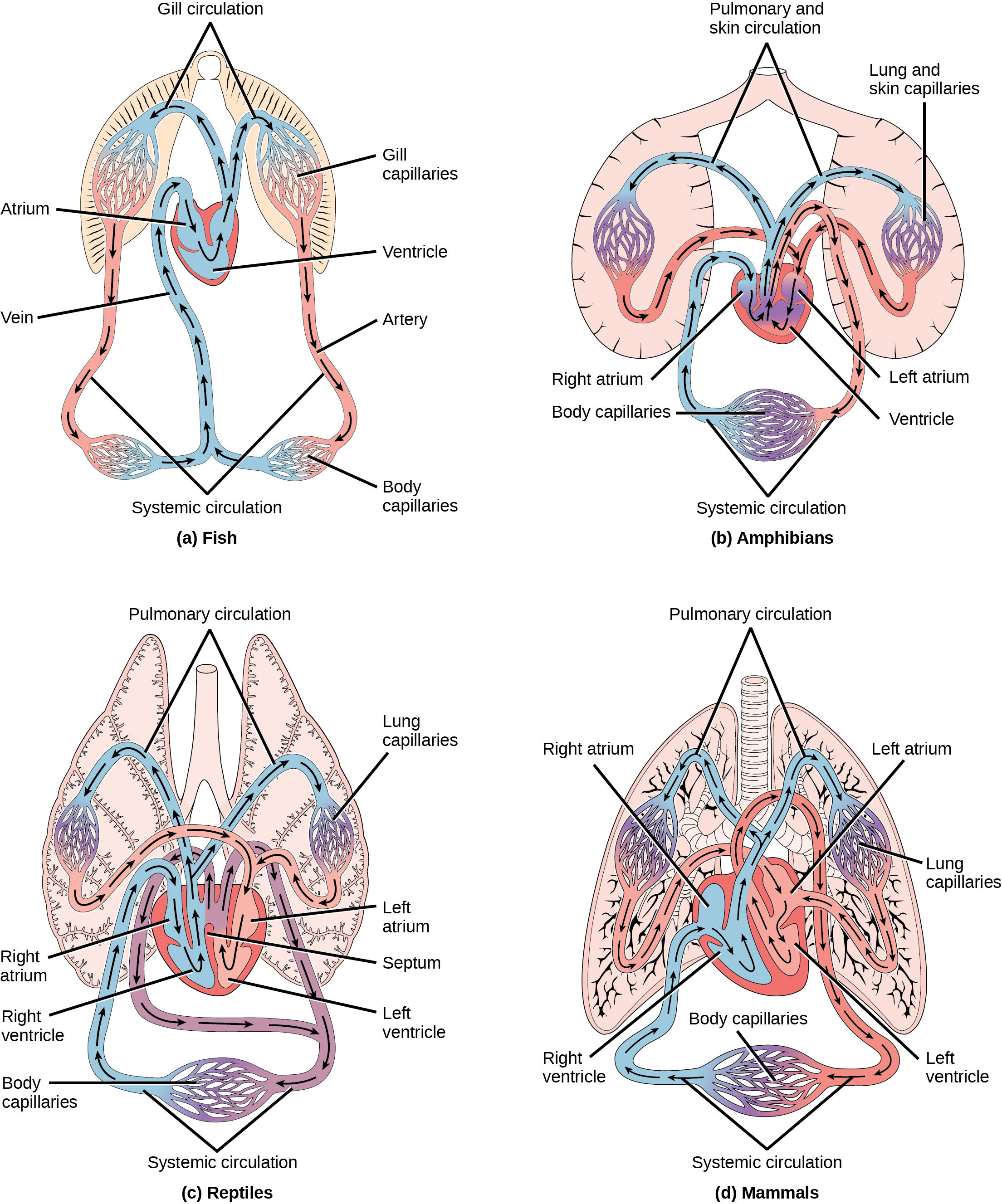Which Of The Following Animals Has A Two-chambered Heart?
The Circulatory System
210 Overview of the Circulatory Organisation
Learning Objectives
By the finish of this section, you lot will be able to do the following:
- Describe an open and closed circulatory system
- Draw interstitial fluid and hemolymph
- Compare and contrast the organization and evolution of the vertebrate circulatory system
In all animals, except a few elementary types, the circulatory system is used to send nutrients and gases through the body. Simple diffusion allows some water, nutrient, waste, and gas exchange into primitive animals that are only a few cell layers thick; nevertheless, bulk menstruum is the only method by which the entire body of larger more circuitous organisms is accessed.
Circulatory System Architecture
The circulatory system is effectively a network of cylindrical vessels: the arteries, veins, and capillaries that emanate from a pump, the centre. In all vertebrate organisms, also every bit some invertebrates, this is a closed-loop system, in which the blood is not free in a cavity. In a closed circulatory system, claret is independent inside blood vessels and circulates unidirectionally from the middle around the systemic circulatory route, then returns to the eye again, as illustrated in (Figure)a. As opposed to a closed system, arthropods—including insects, crustaceans, and nearly mollusks—have an open circulatory arrangement, equally illustrated in (Effigy)b. In an open circulatory system, the blood is not enclosed in the blood vessels but is pumped into a cavity called a hemocoel and is chosen hemolymph because the claret mixes with the interstitial fluid. As the eye beats and the creature moves, the hemolymph circulates around the organs within the body cavity and then reenters the hearts through openings chosen ostia. This movement allows for gas and nutrient exchange. An open circulatory arrangement does not use every bit much free energy as a closed organization to operate or to maintain; nonetheless, there is a trade-off with the corporeality of blood that tin be moved to metabolically active organs and tissues that crave loftier levels of oxygen. In fact, i reason that insects with wing spans of upwardly to two feet broad (70 cm) are not effectually today is probably because they were outcompeted by the arrival of birds 150 million years ago. Birds, having a closed circulatory organisation, are thought to have moved more than agilely, allowing them to get food faster and possibly to prey on the insects.
In (a) closed circulatory systems, the centre pumps blood through vessels that are separate from the interstitial fluid of the body. Most vertebrates and some invertebrates, like this annelid earthworm, have a closed circulatory arrangement. In (b) open circulatory systems, a fluid called hemolymph is pumped through a claret vessel that empties into the body cavity. Hemolymph returns to the blood vessel through openings chosen ostia. Arthropods like this bee and nearly mollusks take open circulatory systems.

Circulatory System Variation in Animals
The circulatory system varies from elementary systems in invertebrates to more than complex systems in vertebrates. The simplest animals, such as the sponges (Porifera) and rotifers (Rotifera), practise not need a circulatory system considering diffusion allows acceptable exchange of water, nutrients, and waste, as well equally dissolved gases, as shown in (Figure)a. Organisms that are more than complex but however merely take two layers of cells in their trunk plan, such as jellies (Cnidaria) and comb jellies (Ctenophora) also use diffusion through their epidermis and internally through the gastrovascular compartment. Both their internal and external tissues are bathed in an aqueous surroundings and exchange fluids by diffusion on both sides, as illustrated in (Figure)b. Substitution of fluids is assisted past the pulsing of the jellyfish body.
Simple animals consisting of a single jail cell layer such as the (a) sponge or only a few jail cell layers such as the (b) jellyfish do non have a circulatory system. Instead, gases, nutrients, and wastes are exchanged past diffusion.

For more than circuitous organisms, improvidence is not efficient for cycling gases, nutrients, and waste effectively through the torso; therefore, more complex circulatory systems evolved. About arthropods and many mollusks have open up circulatory systems. In an open arrangement, an elongated beating heart pushes the hemolymph through the body and musculus contractions help to motion fluids. The larger more than complex crustaceans, including lobsters, have developed arterial-like vessels to push claret through their bodies, and the most active mollusks, such every bit squids, have evolved a closed circulatory system and are able to move quickly to catch casualty. Airtight circulatory systems are a characteristic of vertebrates; however, at that place are significant differences in the structure of the heart and the circulation of blood between the dissimilar vertebrate groups due to accommodation during development and associated differences in anatomy. (Effigy) illustrates the bones circulatory systems of some vertebrates: fish, amphibians, reptiles, and mammals.
(a) Fish have the simplest circulatory systems of the vertebrates: blood flows unidirectionally from the two-chambered eye through the gills and so the rest of the body. (b) Amphibians have ii circulatory routes: one for oxygenation of the blood through the lungs and skin, and the other to take oxygen to the balance of the trunk. The claret is pumped from a three-chambered heart with two atria and a single ventricle. (c) Reptiles also have two circulatory routes; however, blood is but oxygenated through the lungs. The heart is three chambered, simply the ventricles are partially separated and then some mixing of oxygenated and deoxygenated blood occurs except in crocodilians and birds. (d) Mammals and birds have the most efficient center with four chambers that completely divide the oxygenated and deoxygenated claret; information technology pumps only oxygenated claret through the body and deoxygenated claret to the lungs.

Equally illustrated in (Figure)a. Fish have a single excursion for blood menses and a two-chambered middle that has merely a single atrium and a unmarried ventricle. The atrium collects blood that has returned from the body and the ventricle pumps the claret to the gills where gas exchange occurs and the blood is re-oxygenated; this is chosen gill apportionment. The blood then continues through the rest of the body before arriving back at the atrium; this is called systemic circulation. This unidirectional flow of blood produces a gradient of oxygenated to deoxygenated blood around the fish'due south systemic excursion. The effect is a limit in the amount of oxygen that can attain some of the organs and tissues of the body, reducing the overall metabolic chapters of fish.
In amphibians, reptiles, birds, and mammals, claret flow is directed in 2 circuits: ane through the lungs and dorsum to the heart, which is called pulmonary circulation, and the other throughout the remainder of the body and its organs including the brain (systemic circulation). In amphibians, gas commutation likewise occurs through the skin during pulmonary apportionment and is referred to every bit pulmocutaneous circulation.
Equally shown in (Figure)b, amphibians take a three-chambered heart that has two atria and one ventricle rather than the ii-chambered heart of fish. The two atria (superior heart chambers) receive blood from the two unlike circuits (the lungs and the systems), so in that location is some mixing of the blood in the heart's ventricle (inferior heart chamber), which reduces the efficiency of oxygenation. The advantage to this organization is that loftier pressure in the vessels pushes blood to the lungs and body. The mixing is mitigated by a ridge inside the ventricle that diverts oxygen-rich claret through the systemic circulatory system and deoxygenated blood to the pulmocutaneous excursion. For this reason, amphibians are often described as having double circulation.
Near reptiles also have a three-chambered middle similar to the amphibian heart that directs blood to the pulmonary and systemic circuits, every bit shown in (Figure)c. The ventricle is divided more effectively by a partial septum, which results in less mixing of oxygenated and deoxygenated claret. Some reptiles (alligators and crocodiles) are the most primitive animals to showroom a four-chambered centre. Crocodilians take a unique circulatory mechanism where the heart shunts blood from the lungs toward the stomach and other organs during long periods of submergence, for instance, while the animal waits for prey or stays underwater waiting for prey to rot. One adaptation includes two main arteries that leave the aforementioned part of the eye: 1 takes blood to the lungs and the other provides an alternate route to the stomach and other parts of the body. 2 other adaptations include a pigsty in the heart betwixt the two ventricles, called the foramen of Panizza, which allows claret to motion from one side of the heart to the other, and specialized connective tissue that slows the blood flow to the lungs. Together these adaptations have made crocodiles and alligators ane of the most evolutionarily successful animal groups on earth.
In mammals and birds, the heart is also divided into iv chambers: two atria and two ventricles, every bit illustrated in (Figure)d. The oxygenated claret is separated from the deoxygenated blood, which improves the efficiency of double circulation and is probably required for the warm-blooded lifestyle of mammals and birds. The four-chambered heart of birds and mammals evolved independently from a three-chambered heart. The independent evolution of the same or a similar biological trait is referred to as convergent evolution.
Section Summary
In most animals, the circulatory system is used to transport claret through the body. Some archaic animals utilize diffusion for the commutation of water, nutrients, and gases. However, circuitous organisms use the circulatory system to comport gases, nutrients, and waste matter through the body. Circulatory systems may be open up (mixed with the interstitial fluid) or airtight (separated from the interstitial fluid). Airtight circulatory systems are a characteristic of vertebrates; however, in that location are significant differences in the structure of the heart and the circulation of blood between the different vertebrate groups due to adaptions during development and associated differences in anatomy. Fish have a 2-chambered eye with unidirectional apportionment. Amphibians take a 3-chambered heart, which has some mixing of the blood, and they have double circulation. Most non-avian reptiles have a iii-chambered heart, just accept picayune mixing of the blood; they have double apportionment. Mammals and birds have a four-chambered middle with no mixing of the blood and double circulation.
Review Questions
Why are open up circulatory systems advantageous to some animals?
- They apply less metabolic energy.
- They help the animal move faster.
- They do non demand a heart.
- They assistance big insects develop.
A
Some animals utilise diffusion instead of a circulatory organisation. Examples include:
- birds and jellyfish
- flatworms and arthropods
- mollusks and jellyfish
- none of the above
D
Claret flow that is directed through the lungs and back to the heart is chosen ________.
- unidirectional circulation
- gill circulation
- pulmonary circulation
- pulmocutaneous circulation
C
Critical Thinking Questions
Draw a closed circulatory system.
A closed circulatory system is a airtight-loop system, in which claret is non free in a cavity. Blood is divide from the bodily interstitial fluid and independent within blood vessels. In this type of organization, claret circulates unidirectionally from the heart around the systemic circulatory road, and so returns to the heart.
Depict systemic circulation.
Systemic circulation flows through the systems of the body. The blood flows away from the heart to the brain, liver, kidneys, stomach, and other organs, the limbs, and the muscles of the trunk; it and then returns to the heart.
Glossary
- atrium
- (plural: atria) bedchamber of the heart that receives claret from the veins and sends claret to the ventricles
- closed circulatory system
- arrangement in which the blood is separated from the bodily interstitial fluid and contained in claret vessels
- double apportionment
- menstruation of blood in two circuits: the pulmonary excursion through the lungs and the systemic circuit through the organs and torso
- gill apportionment
- circulatory system that is specific to animals with gills for gas substitution; the blood flows through the gills for oxygenation
- hemocoel
- crenel into which blood is pumped in an open up circulatory system
- hemolymph
- mixture of blood and interstitial fluid that is found in insects and other arthropods as well as most mollusks
- interstitial fluid
- fluid between cells
- open up circulatory system
- system in which the blood is mixed with interstitial fluid and directly covers the organs
- ostium
- (plural: ostia) holes between blood vessels that allow the move of hemolymph through the body of insects, arthropods, and mollusks with open circulatory systems
- pulmocutaneous circulation
- circulatory organization in amphibians; the flow of claret to the lungs and the moist pare for gas commutation
- pulmonary circulation
- flow of blood away from the eye through the lungs where oxygenation occurs and so returns to the heart again
- systemic circulation
- catamenia of blood abroad from the heart to the brain, liver, kidneys, stomach, and other organs, the limbs, and the muscles of the body, and so the render of this blood to the heart
- unidirectional circulation
- menstruation of blood in a single circuit; occurs in fish where the claret flows through the gills, then past the organs and the rest of the trunk, before returning to the middle
- ventricle
- (eye) large inferior bedchamber of the heart that pumps blood into arteries
Source: https://opentextbc.ca/biology2eopenstax/chapter/overview-of-the-circulatory-system/
Posted by: lokencarturestry85.blogspot.com

0 Response to "Which Of The Following Animals Has A Two-chambered Heart?"
Post a Comment